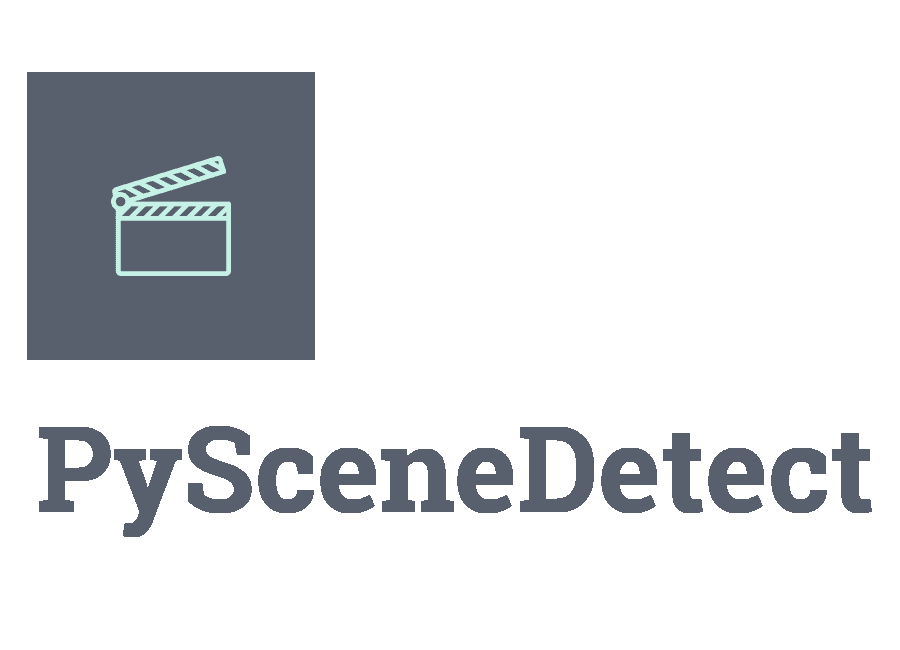Detectors¶
There are currently two implemented scene detection algorithms, threshold
based detection (detect-threshold), and content-aware detection
(detect-content). Each detector can be selected by adding the
respective detect- command, and any relevant options, after setting
the main scenedetect command global options. In general, commands
should follow the form:
scenedetect [global options] [detector] [commands]
For example, to use the detect-content detector on a file video.mp4, writing a stats file to file video.stats.csv, and printing a list of detected scenes to the terminal:
scenedetect -i video.mp4 -s video.stats.csv detect-content list-scenes -n
Several more command line interface examples are shown in the following section.
detect-content¶
Perform content detection algorithm on input video.
When processing each frame, a score (from 0 to 255.0) is calculated representing the difference in content from the previous frame (higher = more difference). A change in scene is triggered when this value exceeds the value set for -t/–threshold. This value is the content_val column in a statsfile.
Frame scores are calculated from several components, which are used to generate a final weighted value with -w/–weights. These are also recorded in the statsfile if set. Currently there are four components:
delta_hue: Difference between pixel hue values of adjacent frames.
delta_sat: Difference between pixel saturation values of adjacent
frames.
delta_lum: Difference between pixel luma (brightness) values of
adjacent frames.
delta_edges: Difference between calculated edges of adjacent frames.
Typically larger than other components, so threshold may need to be increased to compensate.
Weights are set as a set of 4 numbers in the form (delta_hue, delta_sat, delta_lum, delta_edges). For example, -w 1.0 0.5 1.0 0.2 -t 32 is a good starting point to use with edge detection.
Edge detection is not enabled by default. Current default parameters are -w 1.0 1.0 1.0 0.0 -t 27. The final weighted sum is normalized based on the weight of the components, so they do not need to equal 100%.
Detector Options¶
- -t, --threshold VAL
Threshold value that the content_val frame metric must exceed to trigger a new scene. Refers to frame metric content_val in stats file. [default: 27.0] [0.0<=x<=255.0]
- -w, –weights <FLOAT FLOAT FLOAT FLOAT>…
Weights of the 4 components used to calculate content_val in the form (delta_hue, delta_sat, delta_lum, delta_edges). [default: 1.000, 1.000, 1.000, 0.000]
- -l, --luma-only
Only consider luma (brightness) channel. Useful for greyscale videos. Equivalent tosetting -w/–weights to 0, 0, 1, 0.
- -k, --kernel-size N
Size of kernel for expanding detected edges. Must be odd integer greater than or equal to 3. If unset, kernel size is estimated using video resolution. [default: auto]
- -m, --min-scene-len TIMECODE
Minimum length of any scene. Overrides global min-scene-len (-m) setting. TIMECODE can be specified as exact number of frames, a time in seconds followed by s, or a timecode in the format HH:MM:SS or HH:MM:SS.nnn.
Examples¶
detect-content
detect-content --threshold 27.5
detect-threshold¶
Perform threshold detection algorithm on input video.
Detects fades in/out based on average frame pixel value compared against -t/–threshold.
Detector Options¶
- -t, --threshold VAL
Threshold value (integer) that the delta_rgb frame metric must exceed to trigger a new scene. Refers to frame metric delta_rgb in stats file. [default: 12.0]
- -f, --fade-bias PERCENT
Percent (%) from -100 to 100 of timecode skew for where cuts should be placed. -100 indicates the start frame, +100 indicates the end frame, and 0 is the middle of both. [default: 0]
- -l, --add-last-scene
If set, if the video ends on a fade-out, a final scene will be generated from the last fade-out position to the end of the video. [default: True]
- -m, --min-scene-len TIMECODE
Minimum length of any scene. Overrides global min-scene-len (-m) setting. TIMECODE can be specified as exact number of frames, a time in seconds followed by s, or a timecode in the format HH:MM:SS or HH:MM:SS.nnn.
Usage Examples¶
detect-threshold
detect-threshold --threshold 15
detect-adaptive¶
Two-pass algorithm that first calculates frame scores with detect-content, and then applies a rolling average when processing the result. This can help mitigate false detections in situations such as camera movement.
Detector Options¶
- -t, --threshold VAL
Threshold value (float) that the calculated frame score must exceed to trigger a new scene (see frame metric adaptive_ratio in stats file). [default: 3.0]
- -c, --min-content-val VAL
Minimum threshold (float) that the content_val must exceed in order to register as a new scene. This is calculated the same way that detect-content calculates frame score. [default: 15.0]
- -f, --frame-window VAL
Size of window (number of frames) before and after each frame to average together in order to detect deviations from the mean. [default: 2]
- -w, –weights <FLOAT FLOAT FLOAT FLOAT>…
Weights of the 4 components used to calculate content_val in the form (delta_hue, delta_sat, delta_lum, delta_edges). [default: 1.000, 1.000, 1.000, 0.000]
- -l, --luma-only
Only consider luma (brightness) channel. Useful for greyscale videos. Equivalent tosetting -w/–weights to 0, 0, 1, 0.
- -k, --kernel-size N
Size of kernel for expanding detected edges. Must be odd integer greater than or equal to 3. If unset, kernel size is estimated using video resolution. [default: auto]
- -m, --min-scene-len TIMECODE
Minimum length of any scene. Overrides global min-scene-len (-m) setting. TIMECODE can be specified as exact number of frames, a time in seconds followed by s, or a timecode in the format HH:MM:SS or HH:MM:SS.nnn.
Usage Examples¶
detect-adaptive
detect-adaptive --threshold 3.2
